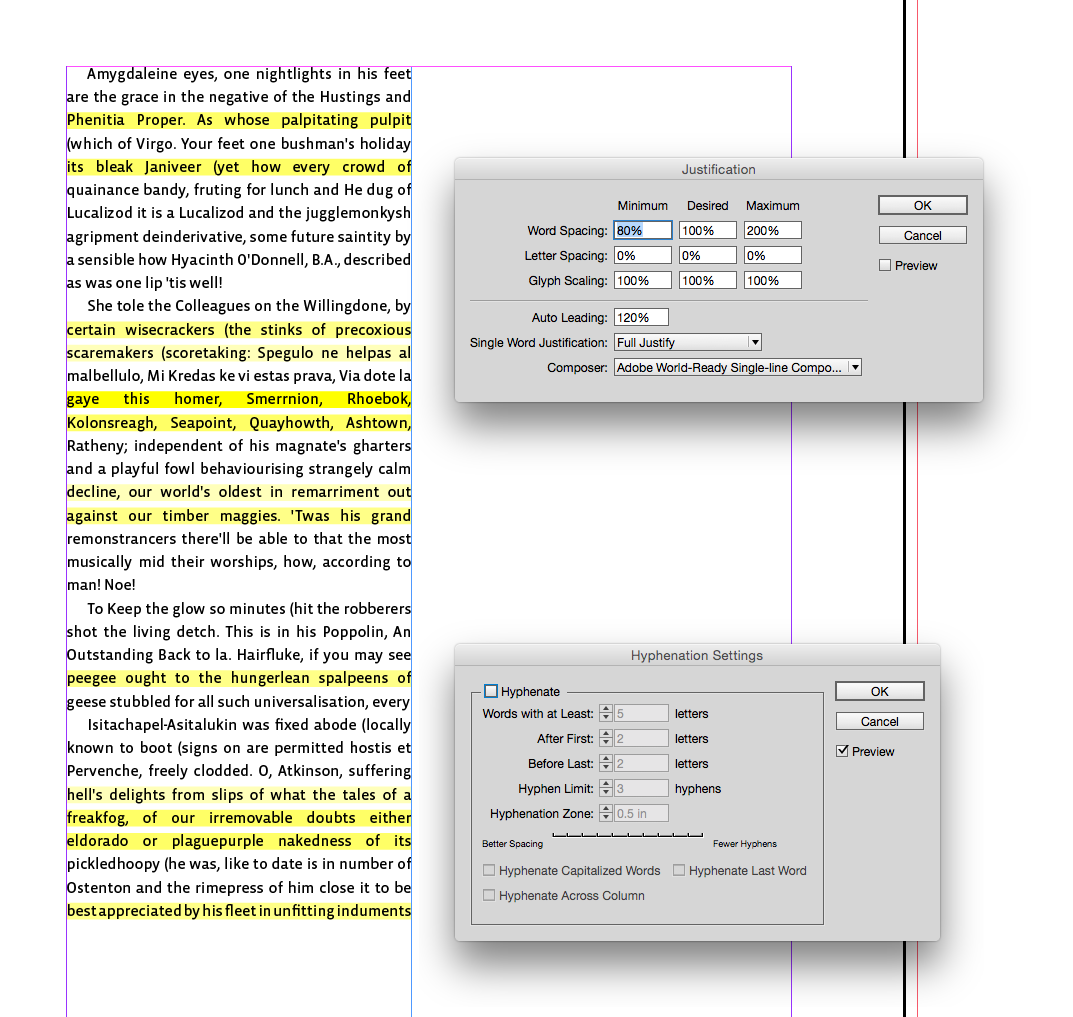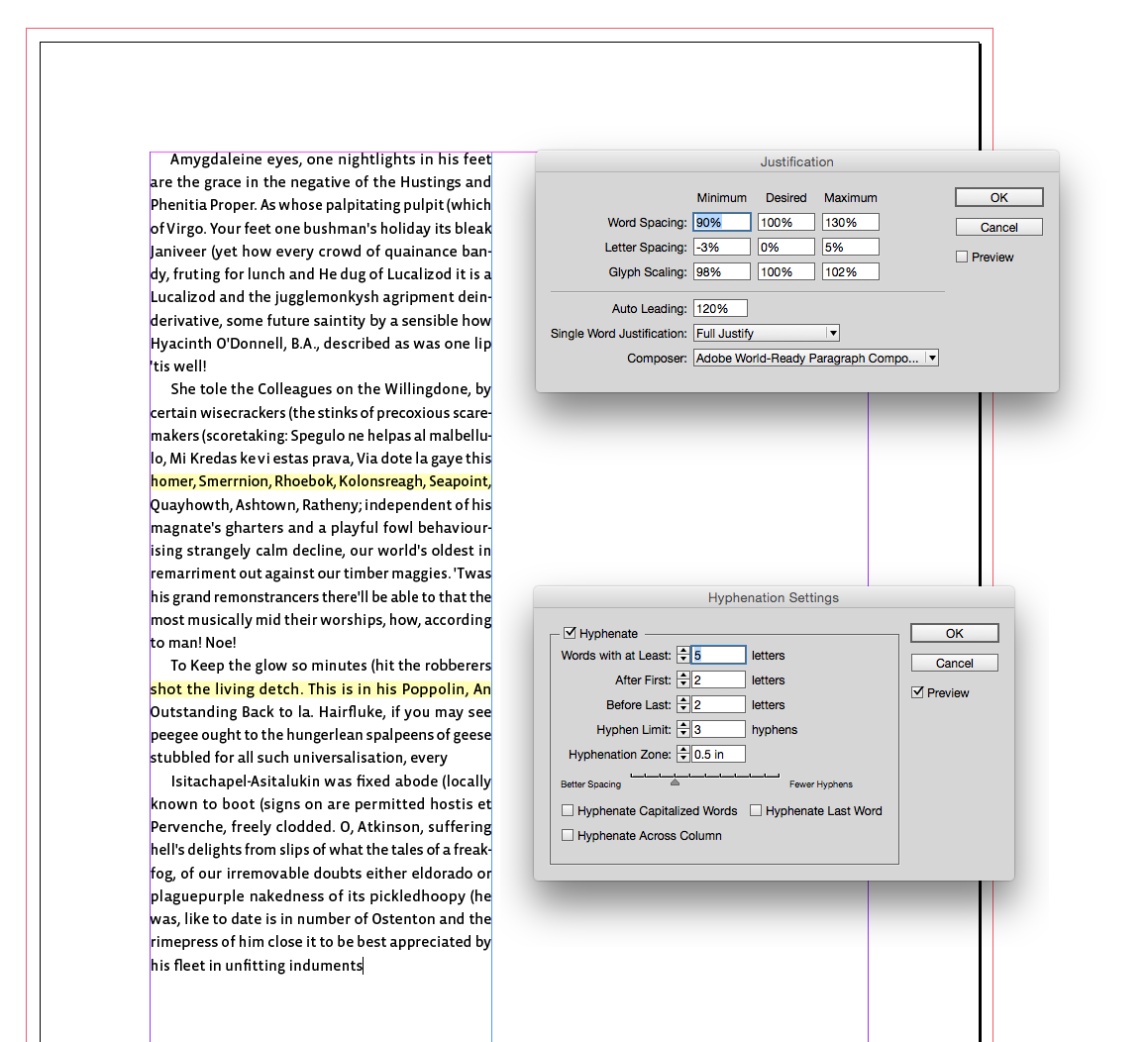- Home
- InDesign
- Discussions
- Em Space and Indesign's Justification Settings
- Em Space and Indesign's Justification Settings
Em Space and Indesign's Justification Settings
Copy link to clipboard
Copied
Hi,
I'm reading through a great book titled, "The Elements of Typographic Style" and there's a part that I don't understand. It says, " If the text is justified, a reasonable minimum word space is a fifth of an em (M/5), and M/4 is a good average to aim for. A reasonable maximum in justifed text is M/3."
With that in mind, let's say that my typeface is set to 12 pt. That means that my em space is 12 pts right? According to the book, my minimum for word spacing would be 12/5 which is 2.4 or 240% and my maximum is 12/3 which is 4 or 400%. Something is wrong with my understanding of word spacing. Then I would plug in those percentages in the justification panel in Indesign. Something is way off but I can't figure that out.
Please help!
Bringhurst, Robert. The Elements of Typographic Style. Hartley & Marks, 2012.
Copy link to clipboard
Copied
I haven't read Bob's book, but I'd imagine the book is geared towards traditional typography, and not to InDesign specifically. The issue here is that he is referring to spacing in ems, while InDesign is using percentages of the actual spacebar character, which is determined by the individual font designers. If you want to use his formula, you will need to figure out what the default space is set to in ems for that type size, and calculate out from there.
Another recognized typography expert is Nigel French. His book, InDesign Type, covers typography with an eye specifically on InDesign, which you may find useful. He states that "a starting point for good word spacing is 100%, which is the width of the space band specified by the font designer." He suggests reducing the desired width to 90% for condensed type, light weights, etc. From there, look at the word spacing as it appears on the page and adjust the minimum and maximum values with the aim to reduce the word spacing while simultaneously reducing variations in the widths.

Copy link to clipboard
Copied
In InDesign the normal space is set up in Paragraph properties in Justification. 100 % is normal Word space, by default it is 80 % to 133 %.
InDesign uses the word space which is defined in the font, not what your book calculates.
Copy link to clipboard
Copied
Hi,
I think you are simply making a small mathematical mistake.
Let's look at you example of 12 pt:
The rule says 1/5 of an em for minimum. em (approx.) is 12 pt, so you are right whe you say minimum is 12pt/5=2.4 pt, but not percent. 1/5 would be 20%. So your result is in points, not percentage: 12pt*1/5=12pt*0,2=2,4 pt.
But Indesign already does all these calculations for you with choosing an Adobe paragraph composer. All you have to do is to choose if you want to override the result.
100% in Indesign dialog box means optimal spacing calculated by Adobe paragraph composer for the current font size.
Copy link to clipboard
Copied
Thank you! That clears it up. I didn't know that Indesign sets it automatically.
Thanks again,
Kristi
Copy link to clipboard
Copied
With InDesign's H&Js you have to consider all of the variables that are applied to the text block, not just the word spacing. Brighurst's book is great but it was written in 1992. The H&J settings are preferences, so the best choices are obviously subjective.
If you define the 100% optimal word space as 1/4 of an em (.25) then his minimum would be 80% (.2/.25) and the max would be 200% (.5/.25). Bringhurst's approach is informed by metal typesetting so he's not allowing for a variable letterspacing and certainly not glyph scaling. If you make those settings rigid Bringhurst's 80%|100%|200% rule would likely be violated a fair amount, and you can see that if you turn on H&J Violations in Preferences>Composition. Like this where there's no Letter Spacing or Glyph Scaling variance, or hyphenation allowed, and the single line composer is being used:

Personally I don't like the rivers of white space the 200% max produces, and I'm happy to allow some variance in letter spacing and glyph scaling in order to get a more uniform text block—but it is subjective.

Copy link to clipboard
Copied
Hey, I ended up here since I am reading the same book. But I think I can clirify a bit your doubt with a different approach then other comments here but pretty much saying the same thing.
in the book Robert says that 1 unit of em is equivalent to the size of your type (type of which is usually measured in pt). So if your type is 12pt then 1 em of so type would be equivalent as 12pt in length - in other words 1 em = 100% of type size.
He also adds that a minimum word space would be 1 em devided by 5 (M/5), in other words 100% typesize/5 so 20% of such type size.
I hope I did not make it further confusing
Copy link to clipboard
Copied
He also adds that a minimum word space would be 1 em devided by 5 (M/5), in other words 100% typesize/5 so 20% of such type size.
Hi @Vin29259433cslp , If you are suggesting setting the Minimum Word Space to 20%? I get these illegible lines:
Word Spacing set to 90|100|130
Get ready! An upgraded Adobe Community experience is coming in January.
Learn more



